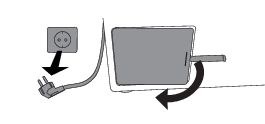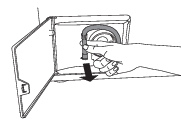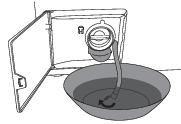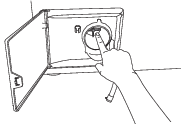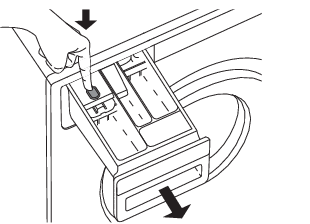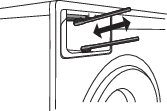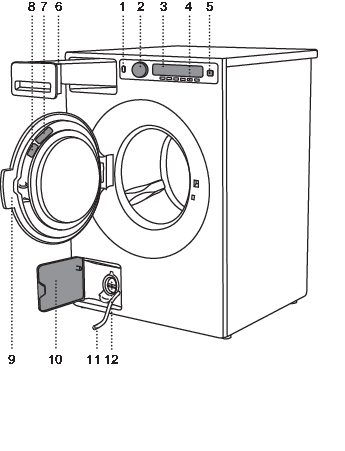
User Manual
Washing machine
WM75.C-P
WMC67XXP
Carefully read the instructions for use before using the washing machine.
Introduction
Dear Customer,
We thank you for purchasing this quality ASKO product.
We hope it meets all your expectations. Scandinavian design combines pure lines, everyday functionality, and high quality. These are the key characteristics of all our products, and the reason why they are highly appreciated across the globe.
We kindly recommend you to read these instructions before using the appliance for the first time. The instruction manual also includes information on how you can help protect the environment.
Link to the EU EPREL database
The QR code on the energy label supplied with the appliance provides a web link to the registration of this appliance in the EU EPREL database. Keep the energy label for reference together with the user manual and all other documents provided with this appliance. It is possible to find information related to the performance of the product in the EU EPREL database using the link https://eprel.ec.europa.eu and the model name and product number that you can find on the rating plate of the appliance. For more detailed information about the energy label, visit www.theenergylabel.eu.
The following symbols are used throughout the manual and they have the following meanings:
Information, advice, tip, or recommendation
Warning – general danger
Warning – danger of electric shock
Warning – danger of hot surface
Warning – danger of fire
Original instructions
See Quick guide on the last page.
Safety precautions
General
 Please read the instruction manual and save it for future reference.
Please read the instruction manual and save it for future reference.
-
Please do not use the washing machine if you have not read and understood these instructions or use first.
-
This appliance is not intended for use by persons (including children) with reduced physical, sensory or mental capabilities, or lack of experience and knowledge, unless they have been given supervision or instruction concerning use of the appliance by a person responsible for their safety.
-
Failure to observe the instructions for use or inappropriate use of the washing machine may result in damage to the laundry or the appliance, or injury to the user. Keep the instruction manual handy, near the washing machine.
-
Instructions for use are available on our website at www.asko.com.
-
This appliance is intended to be used in household and similar applications, such as:
-
staff kitchen areas in shops, offices and other working environments;
-
farm houses;
-
by clients in hotels, motels and other residential type environments;
-
bed and breakfast type environments;
-
areas for communal use in blocks of flats.
For appliances without plug, disconnection must be incorporated in the fixed wiring in accordance with the wiring rules.
-
-
The appliance has to be connected to the water and power supply by a trained expert.
-
Any repair and maintenance pertaining to safety or performance should be done by trained experts.
-
To avoid hazard, damaged power cord may only be replaced by the manufacturer, authorized service technician, or other authorized person.
-
After installation, the washing machine should stand still for two hours before it is connected to the power mains.
-
The washing machine may not be connected to the power mains using an extension cord.
-
Do not connect the washing machine to an electrical outlet intended for an electric shaver or hair dryer.
-
To connect the washing machine to water supply, make sure to use the supplied water supply hose and gaskets. Water pressure has to be between 0.1 and 1 MPa (approximately 1–10 kp/cm2, 1-10 bar, 10–100 N/cm2).
-
Always use a new water supply hose to connect the appliance to water supply; do not reuse an old water supply hose.
-
After the washing cycle, close the water tap and pull out the washing machine plug from the power socket.
If you have a washing machinewith a 3-phase connection, do not pull the plug out of the power outlet.
-
Only use the washing machine for washing laundry, as described in the instruction manual. The machine is not intended for dry cleaning.
-
In case of incorrect appliance connection, incorrect use, or servicing by an unauthorized person, the user shall bear the cost of any damage.
-
Only use detergents intended for the washing machine!
-
Only use agents for machine washing and care of laundry. We shall not be responsible for any damages or discolouration of gaskets and plastic parts resulting from incorrect use of bleaching or colouring agents.
-
Bleaches that contain chlorine can be replaced with oxygen-based bleaches. Otherwise, a neutralization cycle should be performed by running the Cotton program at the highest temperature. For best results, use hydrogen peroxide or oxygen-based detergents.
-
Do not use colourants (dyes) or bleaching substances (substances for discolouration or removal of colourants) as they contain sulphuric compounds that could cause corrosion.
-
Excessive use of products containing chlorine compounds increases the risk of premature failure of appliance components. This depends on the concentration of chlorine, exposure time, and temperature.
-
Do not use detergents that contain solvents as this could lead to release of poisonous gases, damage to the machine, and risk of fire and explosion.
-
Before using the appliance for the first time, remove the transport bolts and all other transport protection devices. See chapter "BEFORE FIRST USE/Transport protection".
-
Emergency door opening tool is located on the back side of the dispenser.
-
Maximum washing capacity in kg is indicated on the rating plate (or in the PROGRAM TABLE).
Child safety
Children of less than 3 years should be kept away unless continuously supervised.
Children should be supervised to ensure that they do not play with the appliance.
Keep the detergent and conditioner out of reach of children.
-
Before closing the washing machine door and running the program, make sure there is nothing except laundry in the drum (e.g. if a child climbed into the washing machine drum and closed the door from the inside).
-
Activate the child lock. See chapter: SETTINGS
-
The washing machine is made in compliance with all relevant safety standards.
-
This appliance can be used by children aged from 8 years and above and persons with reduced physical, sensory or mental capabilities or lack of experience and knowledge if they have been given supervision or instruction concerning use of the appliance in a safe way and understand the hazards involved.
-
Children shall not play with the appliance.
-
Cleaning and user maintenance shall not be made by children without supervision.
Danger of hot surface
-
At higher washing temperatures, the door glass will heat up. Be careful to avoid burns. Make sure children do not play near the door glass.
Water overflow protection
If the water level in the appliance rises above the normal level, then the excessive water level protection will be activated.
It will shut off the water supply and start pumping out the water.
If the water level does not decrease in 60 seconds, the program will be interrupted (see chapter "ERRORS – WHAT TO DO?").
Transporting/storage during the winter
If you transport or store the appliance in vehicles or rooms that are not heated and where the temperature could drop to below freezing point, please do the following:
-
Clean the drain pump filter. See chapter "CLEANING AND MAINTENANCE".
-
Close the water supply to the washing machine, undo the water supply hose from the water supply tap, and wait until the water flows out of the tap and the hose.
-
After the drain pump filter is emptied, there can still be a small amount of water in the machine. This, however, does not affect the quality and will not damage the appliance.
-
If the washing machine is to be transported, transport protection has to be re-installed before transport (see chapter "BEFORE USING THE APPLIANCE FOR THE FIRST TIME").
SAVE THESE INSTRUCTIONS FOR FUTURE REFERENCE!
Washing machine description
|
|
|
Detergent compartment
|
|
|
1 |
Prewash compartment |
|
|
2 |
Compartment for main wash liquid detergent. Use the foldable barrier (3). |
|
|
|
2 |
Compartment for main wash powder detergent. Do not use the foldable barrier (3). |
|
|
|
4 |
Softener / conditioner compartment |
|
|
|
5 |
Tab for detergent compartment removal |
Before using for the first time
Packaging
Remove all packaging.
Please sort the materials in compliance with local recommendations (see chapter "DISPOSAL").
Transport protection
Before using the appliance, remove the three transport bolts and plastic plugs which protect the appliance during transport.
|
|
|
1 Release and remove the bolts as shown in the figures. |
|
|
2 To remove the plastic plugs holding the bolts, squeeze them and then pull them out. |
|
|
|
3 Remove the caps from the plastic plugs. Push the caps over the three holes in which the plastic plugs were inserted. Save the bolts and plastic plugs if you have to transport your washing machine in the future. |
|
If you wish to transport the washing machine, reinstall the bolts and plastic caps to lock the machine. This will prevent any damage to the machine due to vibrations during transport. If you have lost the transport bolts or plastic caps, replacements can be ordered at your dealer.
Please order three pieces of each item!
|
Art. No. |
ID: |
|---|---|
|
270698 |
Bolt |
|
551188 |
Plastic cap (transport lock) |
Cleaning
Disconnect the washing machine from the power mains and open the door. Clean the washing machine drum with a damp cloth and a mild detergent.
In the case of a 3 phase connection of the appliance, switch off the main socket switch.

Connect the washing machine to the power mains and run the dedicated drum cleaning program. See chapter "WASHING PROCESS; STEP BY STEP (1–8)" /STEP 5: CHOOSE THE PROGRAM.
No program can be started while the door is open.
Settings before first use
When the washing machine is connected (see chapter "INSTALLATION AND CONECTION") and switched on for the first time, choose the preferred language:
For further washing process, see chapter "WASHING PROCESS STEP BY STEP".
The amount of detergent also depends on the hardness of water. For details, see the detergent packaging. Please contact your local water supply company to check the water hardness in your area.
Before the product is dispatched from the factory, every appliance is tested.
As a result, there may be some residual water left in the drain pump filter. This, however, does not affect the quality and will not damage the appliance.
Installation and connection
Positioning the washing machine
The washing machine can be installed as a built-in (integrated) or a free-standing unit. Place the machine on a level surface so that the power outlet on the wall is accessible.
Before connecting the washing machine to the power mains, wait for at least 2 hours until it reaches room temperature.
If the appliance is installed on a plinth or a similar structure, then the appliance must be fixed to it, to avoid the risk of falling. ASKO original accessories are available for this purpose, complete with fixing instructions.
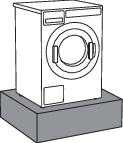
Surface for positioning
The most suitable surface for installation is concrete. Unlike wooden floors or other floor coverings with "soft" characteristics, concrete rarely vibrates during spinning.
*The washing machine must be installed in a vertical and stable position
*Do not place the washing machine on soft floor coverings, otherwise it will vibrate during spinning.
Built-in washing machine
The washing machine can be integrated under a worktop with a height of 900–950 mm. Leave 5 cm of room around the entire appliance, including between the back edge of the upper cover and the wall behind it.
Washing machine installation clearances
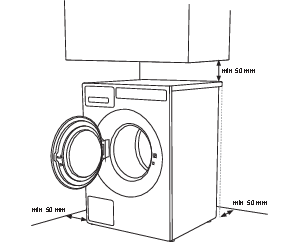
Opening the washing machine door (top view)

Stacking an ASKO dryer on top of an ASKO washing machine
To stack an ASKO dryer on top of a washing machine, use the extra vacuum feet and the tipping guard (A+B), supplied in the cardboard box in the ASKO dryer drum.
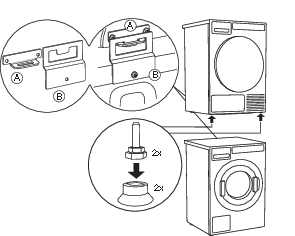
Adjusting the feet
Place the washing machine so that it is stable.
|
|
|
Moving the washing machine and transport after installation
If you are moving the washing machine without packaging, open the washing machine door and pull the appliance by holding the washing assembly, as indicated in the figure.

For any further moving of the appliance, use the transport rods (the washing machine drum has to be blocked).
(See chapter TRANSPORT PROTECTION.)
Connection to water supply
The machine has to be connected to water supply by an adequately trained person.
Use the water supply hose to connect the appliance. Water pressure has to be between 0.1 and 1 MPa (approximately 1–10 kp/cm2, 1-10 bar, 10–100 N/cm2).
If the hoses are newly installed, we recommend rinsing them to remove any impurities. Otherwise, these impurities could clog the filter in the water connection on the washing machine and thus cut off the water supply.
|
|
|
The water intake hose has to be fastened firmly enough for the hose to have a good seal.
After connecting the hose, the seal must be checked for any leaks.
Only use the water supply hose supplied with the appliance. Do not use any used or other hoses.
A single check valve is included in the Set of documents, which must be installed to the cold water supply hose (UK only).
If the connection on the supply hose is of different dimensions than the water tap (e.g. 3/4” → 1/2”), use an adapter.
Connecting to hot/cold water supply
(Only available in some models)
If your appliance has connections for both hot and cold water, then connect one hose to the cold water connection and the other hose to the hot water connection, as indicated on the back of the appliance:
COLD = cold and HOT = hot.
Hot water is supplied for programs operating at 40 °C or more.
Hot water connection:
The hot water temperature must not exceed 70°C (60°C in the UK (United Kingdom)).
Connecting to both hot and cold water will save time and electric energy when washing.
If your washing machine model has connections for both hot and cold water, and you only wish to connect cold water, then the protective cap has to be (or remain) attached to the hot water connection.
Installing the drain hose
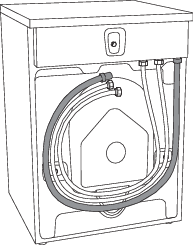
Upon delivery, the appliance has a drain hose attached. This drain hose must be connected to a drain. Drain hose can also be attached to a wall drain with a trap; such trap should be properly installed to allow cleaning. The height of the drain should be 600–900 mm above the floor. The lower position (600 mm) is always recommended. Make sure the drain hose is not clipped or bent.
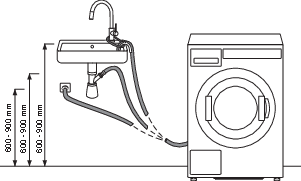
Drain hose can also be connected directly to the washbasin drain via a siphon. In this case, the hose, should be 600–900 mm above the floor. Internal hose diameter should be at least 18 mm.
See figure.
 At least 18 mm
At least 18 mm
Connecting to the power mains
After installation, the washing machine should stand still for two hours before it is connected to the power mains.
Connect the appliance to an earthed power outlet. After installation, the wall outlet should be freely accessible. The outlet should be fitted with an earth contact (in compliance with the relevant regulations).
If you have a washing machine with a 3-phase connection, the connection must be carried out by a qualified and authorized specialist.
Connection upon delivery

Information about your washing machine is indicated on the rating (type) plate.
Use the type A differential current protection switch.
We recommend using over-voltage protection to protect the appliance in case of a lightning strike.
The washing machine may not be connected to the power mains using an extension cord.
Do not connect the washing machine to an electrical outlet intended for an electric shaver or hair dryer.
Any repair and maintenance pertaining to safety or performance should be done by trained experts.
Coin operation
(Only available in some models)
The machine is prepared for coin operation.
Owner/distributor can find detailed informations in Service manual.
Such installation must be carried out by a qualified professional.
The coin meter shall be able to short circuit two signal lines for periods of up to 10 minutes.
This will allow the user to load the appliance, choose a program and start the program after inserting the coins.
"Please pay to continue" appears on the display when the machine is started with the main power switch (by pressing on button Start).
Tips before washing
This chapter includes several tips on how to prepare the laundry for washing.
Laundry sorting
Sort the laundry according to:
-
how soiled it is,
-
colour,
-
material.
Clothing
-
Close the zips and hook-and-loop fasteners so that they do not damage the fabric.
-
New dyed items may contain excess dye; therefore, they have to be washed separately several times.
-
Turn delicate items inside out. This will decrease the risk of tear and colour fading.
-
Place very sensitive clothes and small items in a special-purpose laundry washing bag.
-
Empty the pockets and turn them inside out.

Laundry symbols
Observe the laundry symbols.
Textile maintenance symbols:
|
|
||
|
Normal |
Delicate |
|
|
|
Max. washing temperature 90 °C |
|
|
|
Max. washing temperature 60 °C |
|
|
|
Max. washing temperature 40 °C |
|
|
|
Max. washing temperature 30 °C |
|
|
|
Hand wash only |
|
|
|
Do not wash |
|
|
|
||
|
|
Bleaching in cool water |
|
|
|
Bleaching not allowed |
|
|
|
||
|
|
Dry cleaning with all agents |
|
|
|
Perchloroethylene R11, R113, petroleum |
|
|
|
Dry cleaning in kerosene, pure alcohol, and R113 |
|
|
|
Dry cleaning not allowed |
|
|
|
||
|
|
Ironing with a hot iron with a maximum temperature of 200 °C |
|
|
|
Ironing with a hot iron with a maximum temperature of 150°C |
|
|
|
Ironing with a warm iron with a maximum temperature of 110°C |
|
|
|
Ironing not allowed |
|
|
|
||
|
|
Drying on a flat surface |
|
|
|
Drying without prior spinning |
|
|
|
Drying on a clothes line or a hanger |
|
|
|
||
|
|
Drying at high temperatures |
|
|
|
Drying at low temperatures |
|
|
|
Tumble drying not allowed |
|
Dyed cotton
Laundry made of dyed cotton which is to be washed at 60 °C should be first washed at a temperature of 60 °C to remove the excess dye. If this is not done, there is danger of dye being washed out of such items. To maintain the colour of the fabric, use bleach-free detergent.
Unbleached linen
Unbleached lining fabric should be washed at 60 °C with a detergent free of bleach or optical bleaching agents. Heavily soiled linen laundry may be occasionally washed at higher temperatures, but do not do this too often as heat could ruin the sheen and strength of linen clothing.
Wool
These fabrics are intended for either machine or hand wash. The Wool Wash program is equally gentle or even gentler than an actual hand wash.
Wool in particular is sensitive to washing and similar procedures.
Viscose and synthetic fibres
Materials made of viscose and some synthetic fibres are highly sensitive, and require a lot of space in order not to crease.
Viscose and acetates are fragile when wet.
Reducing allergic reactions
The options include washing with the Allergy Program Cotton and Allergy Program Synthetics. These programs can be used for people with sensitive skin, such as those suffering from allergies, or small children.
Saving time and energy
Save time and energy by using the Quick program
Economy and efficiency
You can save a lot of energy by not using the programs operating at higher temperatures.
Choose the Quick program. This will save water and power.
Detergents
Detergents carrying the environment protection label are less harmful to the environment.
Only add the detergents in compliance with the recommendations by detergent manufacturers. Recommended amount of washing detergent at certain loads and water hardness levels are specified on the detergent packaging.
Stains
If your clothes are soiled with stubborn stains (blood, eggs, coffee, grass etc.), they should be appropriately treated before the wash. Then, wash your laundry using the special programs (if your washing machine has them).
Do not use any chemical substances or agents; only use the stain removing detergents.
When using bleaches or stain removal agents, there is danger of rust (corrosion) and discolouration.
To protect the environment, we advise against using powerful chemicals.
Washing process step by step (1-8)
STEP 1: Sort the laundry
See chapter "TIPS BEFORE WASHING".
Use a washing net for underwire bras. Empty the pockets. Coins, nails etc. could damage the machine and the fabric.
STEP 2: Turn on the main switch.

Turning on
Press the  on/off button.
on/off button.
Switching off
Press the  on/off button.
on/off button.
If the machine does not accept the on/off command correctly, wait for at least 8 seconds before pressing any other button.
STEP 3: Open the washing machine door and insert the laundry
Open the washing machine door by pulling the handle towards you.
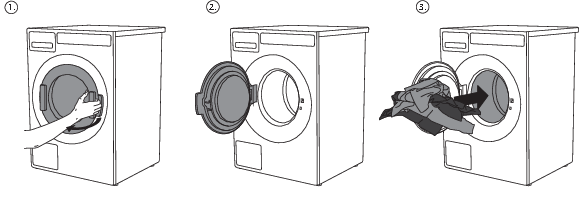
Place the laundry into the washing machine drum.
Before doing so, make sure the drum is empty.
Do not overload the drum!
If the washing machine drum is too full, the laundry will not be washed as thoroughly.
STEP 4: Add the detergent and the softener.
Recommended amount of detergent is usually specified on the detergent packaging. When washing a smaller amount of laundry, the amount of detergent used can be decreased.
Observe manufacturers' recommendations regarding the type of detergent suitable for certain temperatures, load size, and water hardness.
Powder detergent
Add powder detergent into the main wash detergent compartment. If you have selected the Prewash function, Heavy , MOP or Disinfection program, then add powder detergent to the prewash detergent compartment.
We recommend adding the powder detergent immediately before the washing cycle. Otherwise, make sure the detergent compartment is completely dry before adding the powder detergent, as otherwise, the powder detergent may cake before the start of the washing process.
Liquid detergent
When using a liquid detergent, observe the detergent manufacturer's recommendations. When using thick detergents, we recommend always using the laundry balls. Use the barrier (3) in the detergent compartment; see figure in the chapter "Detergent compartment". Add the liquid detergent in the front part of the detergent compartment (2).
Laundry ball or washing bag
If you are using a laundry ball or a washing bag, place it directly into the drum and choose a program without any prewash.
An excessive amount of detergent will not improve washing results. Rather, it will lead to foaming and increase the environmental impact. We recommend using less detergent. Only increase the dosage if you are not satisfied with the washing results.
Softener
Pour the softener into the detergent compartment, into the compartment with the symbol
 . Observe the recommendation on the conditioner packaging.
. Observe the recommendation on the conditioner packaging.
Do not fill the conditioner compartment over the max. indication (maximum indicated level). Otherwise, the conditioner will be added to the washing machine drum too soon, leading to poorer washing effect.
STEP 5: Choose the program.
The display shows the program name, water temperature and spin speed. The washing machine has pre-selected programs when delivered from the factory. You can replace pre-selected programs. Contact the service department about which programs are available and how to change the pre-selected programs or. See section: SETTINGS.
Choose the program by rotating the program selector knob in either direction. Confirm the program selection by pressing the button under the program.

Choose the program depending on the type of laundry and how heavily soiled it is (see chapter "TIPS BEFORE WASHING").
Estimated program duration will appear on the display.
Choose between the following programs:
(owner/distributor can change parameters and rename the program)
|
Programe (factory default program) |
Description |
|
|---|---|---|
|
|
ECO 40-60 |
Washing cycle, which is able to clean normally soiled cotton laundry declared to be washable at 40°C or 60°C. |
|
|
HEAVY 60°C |
For heavily soiled laundry with dirt that needs to be fully dissolved before the main wash. A prewash is used to do this. |
|
|
HEAVY 90°C |
For heavily soiled laundry with dirt that needs to be fully dissolved before the main wash. A prewash is used to do this. |
|
|
WHITE/COLOR 20°C |
Program for normally to heavily soiled laundry, whites and colours. |
|
|
WHITE/COLOR 40°C |
Program for normally to heavily soiled laundry, whites and colours. |
|
|
WHITE/COLOR 60°C |
Program for normally to heavily soiled laundry, whites and colours. |
|
|
WHITE 90°C |
Programme for normally to heaviliy soiled laundry. 90 °C is a good temperature for white and light-coloured cotton, such as bed linen. |
|
|
SUPER QUICK 40°C |
Use this program for laundry that just need freshening up. The lower the selected temperature, the shorter the program time. |
|
|
SUPER QUICK 60°C |
Use this program for laundry that just need freshening up. The lower the selected temperature, the shorter the program time. |
|
|
SYNTHETIC 40 °C |
Program for synthetics, delicate blended fabrics and permanent press cotton. Suitable for shirts and blouses. |
|
|
WOOL/HAND 30°C |
A gentle laundry program for wool, silk and garments that should be washed by hand. This wash program has a short spin. |
|
|
RINSE |
One cold rinse and a short spin cycle. Suitable for laundry that just needs to be rinsed. |
|
|
SPIN |
Use this program when you only want to spin the load. |
|
|
DRAIN |
Use this program when you only want to drain the water from the machine. |
|
|
MOP 60°C |
A program specially developed for cleaning mops. |
|
|
MOP 90°C |
A program specially developed for cleaning mops. |
|
|
MICROFIBRE 40°C |
A program specially developed for cleaning microfibre fabrics. |
|
|
MICROFIBRE 60°C |
A program specially developed for cleaning microfibre fabrics. |
|
|
DISINFECTION 40°C* |
Programme where the temperature reached during the main wash is maintained above 40 °C for 20 minutes. Disinfection at this temperature requires special detergent. |
|
|
DISINFECTION 60°C* |
Programme where the temperature reached during the main wash is maintained above 60 °C for 60 minutes. Disinfection at this temperature requires special detergent. |
|
|
DISINFECTION 90°C* |
Programme where the temperature reached during the main wash is maintained above 90 °C for 10 minutes. Disinfection at this temperature requires special detergent. |
|
|
ALLERGY COTTON 60°C |
This program is used to wash normal to heavily soiled clothes that require special care, such as clothes for people with highly sensitive skin or skin allergies. |
|
|
ALLERGY COTTON 90°C |
This program is used to wash normal to heavily soiled clothes that require special care, such as clothes for people with highly sensitive skin or skin allergies. |
|
|
ALLERGY SYNTHETIC 40°C |
This program is used to wash clothes that require special care, such as clothes for people with highly sensitive skin or skin allergies. |
|
|
ALLERGY SYNTHETIC 60°C |
This program is used to wash clothes that require special care, such as clothes for people with highly sensitive skin or skin allergies. |
|
|
CLEANING |
This program is used to clean the drum and to remove detergent residue and bacteria. The drum must be empty. |
|
. . .
|
PROGRAMS A - J |
Program slot that can be programmed for your needs. See chapter: SETTINGS. |
*Programs Disinfection (40 °C, 60 °C, 90 °C) cannot be canceled during washing program. Complete cycle will be done.
STEP 6: Choosing the program settings
Using the program settings, the washing programs can be further adjusted to your wishes. See chapter: SETTINGS.
(only appliance owner/distributor may change the settings)
Some program settings may not be available for your selected program.
Start delay
Choose the delayed start when you wish the washing program to start after a certain period of time (from 1 h to 100 h after you press the Start button).
Use the Program selector knob to set the delay (from 1 hour to 100 hours in 1-hour steps).
Press the button to confirm your selection.
Start delay time + time remaining until the end of the washing program will be displayed. When the countdown is over, the selected washing program will start .
To cancel the start delay, press the button Cancel.
Then press the Start button to start the program.
When Start delay time is once set, it is not possible to change it; the only possibility is to »Skip it« and continue with chosen program.
If you have set the delayed start function and you are using liquid detergent, we do not recommend choosing a programme with a pre-wash cycle.
STEP 7: Start the wash
Close the washing machine door and press the Start  /Pause button.
/Pause button.

 Start (pressed briefly – start/resume)
Start (pressed briefly – start/resume)
 Pause (short press of the button - pause)
Pause (short press of the button - pause)
Stop (press and hold for 3 seconds – stop or cancel)
Remaining time
Depending on the selected program, anticipated washing time will be displayed in hours and minutes.
Actual washing time will depend on the selected program, load, type of laundry, spin speed etc.
Actual washing time may be longer or shorter than initially displayed.
Remaining time will be updated during the program duration, depending on the actual amount of laundry and amount of water pumped into the machine. The last remaining time update takes place before the final spinning cycle.
In case of uneven distribution of laundry, the time on the display will flash and it will not count down. Once the laundry is evenly redistributed, the washing time will continue and it will stop flashing.
Adding or removing laundry after the start of the program
To add laundry during washing program, you must first select the enable/disable option. (See chapter: SETTINGS).
To add or remove laundry during the progress of a washing program, use the Start/Pause  button to pause the program.
button to pause the program.
The door may be opened when the water is pumped from the machine (but not completely
pumped out). Then, add or remove the laundry. Close the door and continue the program.
Press the Start  /Pause button.
/Pause button.
The program will resume from the point at which it was interrupted.
If the door cannot be opened, it is possible that the temperature in the machine is too high, and you won't be able to add the laundry.
Also, if the door cannot be opened, it is possible that the program has been running for too long and any laundry added at that point would not be efficiently washed.
Pausing, stopping or changing the program
To pause the program, shortly press the Start/Pause  button.
button.
To resume a program, press the Start  /Pause button again.
/Pause button again.
To stop the washing program, press the Start/Pause button and hold it for 3 seconds.
Choose "Stop program". The program is canceled and the water is pumped out of the
machine if necessary. Only then will you be able to open the washing machine door.
Use the Program selector knob to select a new program. If necessary, add detergent,
and then press the Start  /Pause button.
/Pause button.
If the temperature in the drum is very high, then cooling procedure starts before program is canceled.
A washing program can be paused by pressing the ON/OFF button.
The washing machine will switch off.
After the washing machine is switched on, press the Start  button to resume the program.
button to resume the program.
Do not open the detergent compartment while the appliance is operating.
In some cases the door may be locked although no program is in progress (e.g. in case of an error). To unlock the door, press the Start/Pause button and hold it for a while.
STEP 8: End of program
After the end of the washing program, the display will indicate that the program has been successfully completed and that the door is unlocked.
Open the door towards you and remove the laundry from the washing machine.
Make sure the washing machine drum is empty.
If you do not take any action within 5 minutes after the end of the program, the display will switch off to standby mode in order to save power.
The display will light up again if you press the ON/OFF button.
After the washing cycle, close the water tap and pull out the washing machine plug from the power socket.
If you have a washing machine with a 3phase connection, do not pull the plug out of the power outlet.
Settings
Only appliance owner/distributor may change the settings!
(owner/distributor should check Service manual)
|
On display |
Setting |
Description |
|---|---|---|
|
Max. RPM |
no Drain --> max. rpm |
Setting affect all programs |
|
Drain |
Valve/Drain |
Setting of draining via valve or pump, depending on the type of appliance; in case of change, a mechanical change on the appliance is required. |
|
Show temp |
On/Off |
In the Disinfection programs and in the Special programs; this means displaying the actual measured temperature in the drum. |
|
Change program |
On each program (some settings cannot be set on some programs) |
By changing settings it is possible to create and customize your own program. Program can be renamed! |
|
On/Off |
|
|
0 --> max |
°C/°F |
|
no Drain --> max. rpm |
|
|
On/Off |
|
|
On/Off |
|
|
Override existing/Save as new |
Once the above changes are done, you can save the program as a new program or overwrite an existing program. |
|
Spin time |
0 --> 300 |
At max. rpm in the Spinning phase |
|
Temperature unit |
°C/°F |
Choose either °C or °F. |
|
Super rinse |
On/Off |
Additional rinses to the program are added. |
|
Payment system |
On/Off |
With enabled function payment is requested, to be able to start the program. |
|
3D sensor |
On/Off |
|
|
Child Lock |
On/Off |
Choose between switching the Child lock On or Off. When the child lock is activated, no other function can be selected. |
|
Programmes |
|
Selected program will be shown on display |
|
Set Language |
Select your language - press the button under the flag |
|
|
Temporary language selection |
On/Off |
(from 0 to 5) If a temporary language is selected, then the user can temporarily select a language for the time the machine is turned on. |
|
Sound setting |
0 --> 5 |
5 different sound levels can be set. 0 means, sound is turned off. |
|
Display settings: |
||
|
1 --> 5 |
5 different brightness levels can be set. |
|
On/Off |
After turning the appliance on, the introduction text can be turned off, so that is not shown. |
|
Start delay |
On/Off |
1h --> 100h Choose the delayed start when you wish the program to start after a certain time (from 1h to 100h, after you press the Start button). |
|
Heating steps |
On/Off |
Program will be done without heating step, water will not be heated. |
|
Detailed view |
On/Off |
Sub menu for the program can be disabled. User can not go to sub menu. Program can be started directly from the first level of the menu. |
|
Add clothes |
On/Off |
User can pause the program and select option "Add clothes", door will be unlocked and user can add laundry. Add Clothes function is available in Wash phase on majority of the programs. Add clothes function is available also on program Rinse (only during first rinse on Rinse program). If water level is higher than allowed to open door, water will be pumped out. If temp is higher than 50°C, them add clothes option is not shown when pausing the program. |
|
Standby choice |
No standby/Norm |
Selection if appliance will go into Standby after 5min or not. |
|
WiFi settings |
By turning WiFi module On, the energy consumption will increase in standby mode. |
|
|
Programs A - J |
Settings can be changed on each program. |
By changing settings it is possible to create and customize your own program. Program can be renamed! |
Cleaning and maintenance
Cleaning the filter
The washing machine has a filter that will retain smaller objects such as coins, buttons, hair etc.
|
|
1 Before cleaning, drain the water from the washing machine using the Drain program, and disconnect the washing machine from the power mains. Open the pump filter cover using appropriate tools (emergency door opening tool is located on the back side of the dispenser). |
|
|
|
|
2 Release the water drain hose from the holder. Before cleaning the filter, drain the water from the washing machine by placing the end of the water drain hose over a large shallow container and opening the cap on the water drain hose. |
|
|
3 Gradually rotate the filter in the counter-clockwise direction and pull it out. |
|
|
|
4 Clean the filter thoroughly under running water. |
|
|
|
5 Remove all objects and impurities from the filter housing and the impeller. |
|
|
|
6 Replace the filter as shown in the figure and fasten it by rotating in the clockwise direction. For a good seal, the filter seal surface should be clean. Also re-install the drain hose. |
|
Cleaning the detergent compartment and door rubber gasket
|
|
1 Press the tab to completely remove the detergent compartment from its housing. |
|
|
2 Rinse and thoroughly clean the tray. You may also remove the cap from the plug in the conditioner compartment (A). Clean any residue from the cap and tube. Clean the detergent compartment (B) interior. Replace the cap on the plug. |
|
|
3 Use a brush to clean the nozzles on the upper side of the detergent compartment housing. After a washing program, nozzles that clean the interior of the dispenser are automatically switched on (only available in some models). Use a brush to clean the lower part of the detergent compartment housing. |
|
|
4 Replace the detergent dispenser into its housing. Close the detergent compartment! Do not wash the detergent compartment in the dishwasher! |
|
|
5 After every wash, wipe the rubber door seal to extend its useful life. |
Cleaning the appliance exterior
Clean the appliance exterior and the display unit using a soft damp cotton cloth and water. Do not use solvents or abrasive cleaners that could damage the appliance (please observe the recommendations and warnings provided by the manufacturers of the cleaning agents).
Do not clean the washing machine with a jet of water!
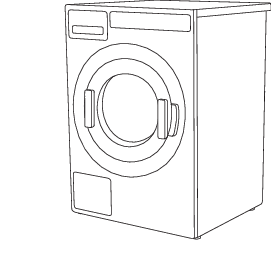
Always disconnect the washing machine from the power mains before cleaning.
In the case of a 3 phase connection of the appliance, switch off the main socket switch.
Cleaning the washing machine interior against odours
Modern detergents often allow washing clothes at low temperatures. This means that residue may accumulate in the washing machine, which in turn could cause odours.
To avoid such odorous, we recommend running the self-cleaning program (Drum-cleaning) once per month. Use a small amount of powder detergent and do not put any laundry in the drum.
Cleaning the rinsing holes (under the agitator in the drum)
If you believe that objects like nails or paper clips fell into the washing machine drum, check the area underneath the agitator. Such objects may rust (corrode) and cause stains on your clothes. Nails and other sharp objects can also cause holes in the fabric.
Proceed as follows:
|
|
1 Insert a screwdriver or a similar tool into the slot in the rib and carefully push it to the left. |
|
|
2 Hold the rib with the other hand and pull it towards you. 3 Lift the drum rib. 4 Remove any objects. |
|
|
5 Place the rib into the installation slot indicated with "F" towards you. Make sure all ribs are firmly in place in their respective slots in the drum. Push the rib inwards (as indicated by the arrow in the figure) until it snaps. |
If you are using hard water
If you are washing with hard water (causing limescale build-up), a greyish-white film may appear on the washing machine drum. To remove this film, add vinegar (approximately 2 dl or sodium bicarbonate “baking soda” (1 tablespoon or 15 g)) into the washing machine drum and select any program with a temperature of 90 °C, or the Drum Cleaning program. See STEP 5: Choose the program.
Repeat the process as necessary.
Errors – what to do?
Disturbances from the environment (e.g. the power grid) may result in various error reports (see Troubleshooting table). In such case:
-
Switch off the appliance, wait for 1 minute, switch the appliance back on, and repeat the washing program.
-
If the error occurs again, call an authorized service unit.
-
You will be able to solve most of the problems in appliance operation by yourself (see Troubleshooting table).
-
Repairs may only be carried out by an adequately trained person.
-
Repair or any warranty claim resulting from incorrect connection or use of the washing machine shall not be covered by the warranty. In such cases, the costs of repair shall be charged to the user.
The warranty does not cover the errors or failures resulting from disturbances from the environment (lightning strike, power grid failures, natural disasters etc.).
|
Problem/error |
Cause |
What to do? |
|---|---|---|
|
Washing machine door does not open. |
|
|
|
|
|
|
Washing program is not in progress. |
|
|
|
|
|
|
|
|
|
|
|
|
Washing time is longer than anticipated (the time is regularly updated on the display unit). |
|
|
|
|
|
|
|
|
|
|
|
|
Display does not light up. |
|
|
|
The wording on the display unit is not in your language. |
|
|
|
Wet laundry ("unbalance" will appear on display) |
|
|
|
There are traces of grease (or grease rolls) on the clothes. |
|
|
|
There are still stains on the laundry. |
|
|
|
|
|
|
There are white residues of washing powder on the laundry. |
|
|
|
There is powder detergent left in the main wash compartment of the detergent compartment. |
|
|
|
|
|
|
There is conditioner left in the conditioner compartment of the detergent compartment. |
|
|
|
Odour in the washing machine drum. |
|
|
|
|
|
|
Machine is moving during operation. |
|
|
|
|
|
|
Machine is moving during spinning. |
|
|
|
Noisy (loud) drain pump |
|
|
Manual opening of washing machine door
Washing machine door may be opened manually if the appliance is not connected to the power mains and if the water has been pumped out of the machine.
-
Choose the Spinning or Drain program to pump the water from the machine. If this does not work, water has to be drained from the washing machine drum manually. See chapter "Cleaning the trap and drain pump" in the chapter "CLEANING AND MAINTENANCE".
-
Make sure the main switch is off and that the plug is disconnected from the power outlet.
If you have a washing machine with a 3phase connection, do not pull the plug out of the power outlet.
-
Take the emergency door opening tool (found at the back of the detergent compartment) and insert it into the upper part of the slot on the right-hand side of the washing machine door latch.
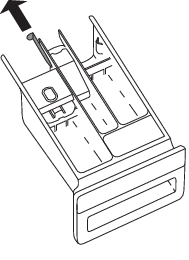
-
Press the key (key=the emergency door opening tool) downwards (all the way, until you hear a click) to unlock the washing machine door. When the door is unlocked, open it by pulling towards you.
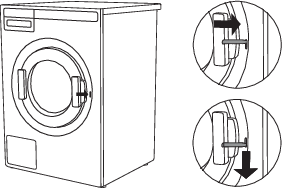
If the washing machine door still cannot be opened, call a service technician.
Failure display
In case of a failure while a program is in progress, the relevant Error XX is indicated on the display unit.
|
|
Press the INFO button to display the error description. Switch off the appliance and turn it back on. |
Errors indicated on the display unit may include the following:
|
Error |
Error indication on the display unit |
What to do? |
|---|---|---|
|
E0 |
Incorrect settings |
Restart the program. If the error reoccurs, call a service technician. |
|
E1 |
Temperature sensor failure |
|
|
E2 |
Door lock error |
Turn the appliance OFF and then switch it again ON. Start the program again. If the error reoccurs, call service technician. |
|
E3 |
Water filling error |
Check the following:
Then, press the Exit button to resume the program. If the error reoccurs call a service technician |
|
E6 |
Water heating error |
Restart the program; if the error reoccurs, call a service technician. |
|
E7 |
Water draining error |
Check the following:
Then, press the Exit button again. If the error reoccurs, call a service technician. |
|
E10 |
Water level sensor error |
Turn the appliance OFF and then switch it again ON. Start the program again. If the error reoccurs, call service technician. |
|
E11 |
Overflow |
If there is water in the drum that exceeds a certain level, and an error is reported on the display unit, the washing program will be interrupted and water will be pumped out of the washing machine. Restart the programme. If the error reoccurs, call a service technician. If there is water in the drum that exceeds a certain level, and an error is reported on the display unit, while the washing machine continues to add water, close the water tap and call a service technician. |
|
E12 |
Motor error / motor control error |
Restart the program; if the error reoccurs, call a service technician. |
|
E23 |
Error while unlocking the door |
Door is closed, but it cannot be unlocked. Turn off the washing machine, then turn it back on. If the error reoccurs, call a service technician. See instructions for opening the door – chapter on manual door opening. |
|
E36 |
Error in UI** and PMCU communication. |
Turn off the appliance and turn it back on. If the error reoccurs, call a service technician. |
|
E37 |
PMCU/UI** software versions are not compatible |
Call a service technician. |
|
E40 |
Voltage value out of range. |
Restart the program. If the error reoccurs, call a service technician. |
|
E41 |
The value of frequency out of range. |
Restart the program. If the error reoccurs, call a service technician. |
|
E45 |
EADBS communication error. |
Call service centre. |
|
Unevenly distributed laundry. |
Manually distribute the laundry and run the spinning program. |
|
|
Unable to lock door |
Open and firmly close the door again to final position. If the error reoccurs, call a service technician. |
|
|
Warning – Self-cleaning program |
Message "Sterile Tube alert" is displayed every 40 completed wash cycles. Use the self-cleaning program (DRUM CLEANING); see STEP 5. |
|
|
Preparing to door unlocking. (press INFO): Draining must be performed. Wait for door unlocking. |
Wait for the process to finish. If no errors are shown after the process, a new cycle can be run. |
|
|
Water drain system alert |
Alert about reduced water flow in the pumping stage. Please check user manuals. |
** UI = (User Interface)
Unevenly distributed laundry or lumps of laundry in the washing machine drum may cause problems such as vibration and noisy operation. The washing machine will sense this and activate the UKS* (*unbalance system).
Smaller loads (e.g. one towel, one sweater, one bathrobe etc.) or clothes made of materials with special geometrical properties are virtually impossible to distribute evenly across the washing machine drum (slippers, large items etc.). This results in several attempts to redistribute the laundry, which in turn leads to longer program duration. In extreme cases of unfavourable conditions, the program can be completed without the spinning cycle.
UKS* (* unbalance system) allows stable operation and extends the useful life of the appliance.
Service
Before calling a service center
When you contact a service centre, please state the model (1), type (2), and serial number (3) of your washing machine.
Model, type, and serial number are indicated on the rating (type) plate located on the washing machine door casing.
In case of a failure, only use approved spare parts by authorized manufacturers.
Repair or any warranty claim resulting from incorrect connection or use of the washing machine shall not be covered by the warranty. In such cases, the costs of repair shall be charged to the user.

Technical information
Performance data
|
Program |
Maximum load |
Temp. °C |
|---|---|---|
|
Eco 40-60 1*) |
7 /3,5* /21*) kg |
|
|
White/Colour2) |
7 /3,5* kg |
60 |
|
Synthetics2) |
3,5 kg |
40 |
1*) PRODUCT INFORMATION SHEET According to EU-Regulation No. 2019/2014
2) 40 °C program for testing institutes. The 40 °C option has to be set.
*Half load
Energy labelling
|
European test standard |
EN 60456 / 1*) |
|
Washing program |
Eco 40-601*) |
|
Connection |
Cold water 15 °C |
|
Noise testing method |
IEC-60704-2-4 |
Technical information
|
Width |
595 mm |
|
Height |
850 mm |
|
Depth |
591 mm |
|
Weight |
76,5 /77,0 /82,5 kg (depending on the model) |
|
Drum volume |
60 l |
|
Rated power |
See rating plate |
|
Heater power |
See rating plate |
|
Water pressure |
0,1–1MPa 1–10kp/cm2 10–100N/cm2 |
|
Emission sound pressure level in accordance with EN ISO 11203 |
< 70 dB re 20 µPa |
|
Material for the drum and dispenser |
Stainless steel |
|
Housing material |
Hot-dip galvanized and powder coated sheet metal, or stainless steel sheet (depending on model) |
|
Water connection |
1,5 m, pex hose |
|
Drain hose |
1,6 m, polypropylene hose |
Program chart
WMC6763PC
7kg_1600_3kW
|
Program |
Prewash |
Temp. °C |
Number of rinses |
Maximum load (kg) |
Spinning speed (rpm) |
Water consumption (approximately, in litres) |
Power consumption (approximately, kWh) |
Program duration (approximately, in hours and minutes) |
||
|---|---|---|---|---|---|---|---|---|---|---|
|
Hot |
Cold |
Sum |
||||||||
|
Eco 40-60 |
2 |
7 |
1600 |
46 |
46 |
0,90 |
2:55 |
|||
|
Heavy wash 60°C |
|
60 |
3 |
7 |
1600 |
5 |
66 |
71 |
1,30 |
1:40 |
|
Heavy wash 90°C |
|
90 |
3 |
7 |
1600 |
5 |
66 |
71 |
2,30 |
2:10 |
|
White/Color 20°C |
20 |
2 |
7 |
1600 |
5 |
45 |
50 |
0,14 |
0:40 |
|
|
White/Color 40°C |
40 |
2 |
7 |
1600 |
50 |
50 |
0,46 |
0:49 |
||
|
White/Color 60°C |
60 |
2 |
7 |
1600 |
50 |
50 |
1,30 |
0:59 |
||
|
White/Color 60°C* |
60 |
2 |
3,5 |
1600 |
31 |
31 |
0,72 |
0:59 |
||
|
White 90°C |
90 |
2 |
7 |
1600 |
9 |
49 |
58 |
2,30 |
1:28 |
|
|
Super quick wash 40°C |
40 |
2 |
3,5 |
800 |
8 |
32 |
40 |
0,30 |
0:35 |
|
|
Super quick wash 60°C |
60 |
2 |
3,5 |
800 |
8 |
40 |
48 |
0,70 |
0:40 |
|
|
Synthetic 40°C |
40 |
2 |
3,5 |
1200 |
8 |
32 |
40 |
0,19 |
0:40 |
|
|
Wool/Hand 30°C |
30 |
2 |
3 |
800 |
5 |
30 |
35 |
0,05 |
0:35 |
|
|
Rinse |
1 |
7 |
1600 |
14 |
14 |
0,07 |
0:22 |
|||
|
Spinning |
/ |
7 |
1600 |
0,06 |
0:17 |
|||||
|
Drain |
/ |
7 |
/ |
0,01 |
0:01 |
|||||
|
MOP 60°C |
|
60 |
3 |
7 |
1600 |
5 |
71 |
76 |
1,20 |
1:30 |
|
MOP 90°C |
|
90 |
3 |
7 |
1600 |
5 |
71 |
76 |
2,20 |
2:00 |
|
Microfibre 40°C |
40 |
2 |
7 |
1600 |
9 |
45 |
54 |
0,26 |
0:55 |
|
|
Microfibre 60°C |
60 |
2 |
7 |
1600 |
9 |
53 |
62 |
0,90 |
1:15 |
|
|
Disinfection 40°C |
|
40 |
3 |
7 |
1600 |
5 |
63 |
68 |
0,80 |
1:35 |
|
Disinfection 60°C |
|
60 |
3 |
7 |
1600 |
5 |
71 |
76 |
1,50 |
2:25 |
|
Disinfection 90°C |
|
90 |
3 |
7 |
1600 |
5 |
71 |
76 |
2,70 |
2:20 |
|
Allergy Cotton 60°C |
60 |
4 |
7 |
1600 |
9 |
77 |
86 |
1,20 |
2:30 |
|
|
Allergy Cotton 90°C |
90 |
4 |
7 |
1600 |
9 |
77 |
86 |
2,80 |
3:00 |
|
|
Allergy Synthetic 40°C |
40 |
3 |
3,5 |
1200 |
9 |
46 |
55 |
0,35 |
1:40 |
|
|
Allergy Synthetic 60°C |
60 |
3 |
3,5 |
1200 |
9 |
54 |
63 |
0,80 |
1:55 |
|
|
Cleaning |
90 |
3 |
/ |
9 |
63 |
72 |
1,10 |
1:10 |
||
|
Program A |
7 |
1600 |
||||||||
|
Program B |
7 |
1600 |
||||||||
|
Program C |
7 |
1600 |
||||||||
|
Program D |
7 |
1600 |
||||||||
|
Program E |
7 |
1600 |
||||||||
|
Program F |
7 |
1600 |
||||||||
|
Program G |
7 |
1600 |
||||||||
|
Program H |
7 |
1600 |
||||||||
|
Program I |
7 |
1600 |
||||||||
|
Program J |
7 |
1600 |
||||||||
WMC6743PB
7kg_1400_3kW
|
Program |
Prewash |
Temp. °C |
Number of rinses |
Maximum load (kg) |
Spinning speed (rpm) |
Water consumption (approximately, in litres) |
Power consumption (approximately, kWh) |
Program duration (approximately, in hours and minutes) |
||
|---|---|---|---|---|---|---|---|---|---|---|
|
Hot |
Cold |
Sum |
||||||||
|
Eco 40-60 |
2 |
7 |
1400 |
46 |
46 |
0,90 |
2:55 |
|||
|
Heavy wash 60°C |
|
60 |
3 |
7 |
1400 |
5 |
66 |
71 |
1,30 |
1:40 |
|
Heavy wash 90°C |
|
90 |
3 |
7 |
1400 |
5 |
66 |
71 |
2,30 |
2:10 |
|
White/Color 20°C |
20 |
2 |
7 |
1400 |
5 |
45 |
50 |
0,14 |
0:40 |
|
|
White/Color 40°C |
40 |
2 |
7 |
1400 |
50 |
50 |
0,46 |
0:49 |
||
|
White/Color 60°C |
60 |
2 |
7 |
1400 |
50 |
50 |
1,30 |
0:59 |
||
|
White/Color 60°C* |
60 |
2 |
3,5 |
1400 |
31 |
31 |
0,72 |
0:59 |
||
|
White 90°C |
90 |
2 |
7 |
1400 |
9 |
49 |
58 |
2,30 |
1:28 |
|
|
Super quick wash 40°C |
40 |
2 |
3,5 |
800 |
8 |
32 |
40 |
0,30 |
0:35 |
|
|
Super quick wash 60°C |
60 |
2 |
3,5 |
800 |
8 |
40 |
48 |
0,70 |
0:40 |
|
|
Synthetic 40°C |
40 |
2 |
3,5 |
1200 |
8 |
32 |
40 |
0,19 |
0:40 |
|
|
Wool/Hand 30°C |
30 |
2 |
3 |
800 |
5 |
30 |
35 |
0,05 |
0:35 |
|
|
Rinse |
1 |
7 |
1400 |
14 |
14 |
0,07 |
0:22 |
|||
|
Spinning |
/ |
7 |
1400 |
0,06 |
0:17 |
|||||
|
Drain |
/ |
7 |
/ |
0,01 |
0:01 |
|||||
|
MOP 60°C |
|
60 |
3 |
7 |
1400 |
5 |
71 |
76 |
1,20 |
1:30 |
|
MOP 90°C |
|
90 |
3 |
7 |
1400 |
5 |
71 |
76 |
2,20 |
2:00 |
|
Microfibre 40°C |
40 |
2 |
7 |
1400 |
9 |
45 |
54 |
0,26 |
0:55 |
|
|
Microfibre 60°C |
60 |
2 |
7 |
1400 |
9 |
53 |
62 |
0,90 |
1:15 |
|
|
Disinfection 40°C |
|
40 |
3 |
7 |
1400 |
5 |
63 |
68 |
0,80 |
1:35 |
|
Disinfection 60°C |
|
60 |
3 |
7 |
1400 |
5 |
71 |
76 |
1,50 |
2:25 |
|
Disinfection 90°C |
|
90 |
3 |
7 |
1400 |
5 |
71 |
76 |
2,70 |
2:20 |
|
Allergy Cotton 60°C |
60 |
4 |
7 |
1400 |
9 |
77 |
86 |
1,20 |
2:30 |
|
|
Allergy Cotton 90°C |
90 |
4 |
7 |
1400 |
9 |
77 |
86 |
2,80 |
3:00 |
|
|
Allergy Synthetic 40°C |
40 |
3 |
3,5 |
1200 |
9 |
46 |
55 |
0,35 |
1:40 |
|
|
Allergy Synthetic 60°C |
60 |
3 |
3,5 |
1200 |
9 |
54 |
63 |
0,80 |
1:55 |
|
|
Cleaning |
90 |
3 |
/ |
9 |
63 |
72 |
1,10 |
1:10 |
||
|
Program A |
7 |
1400 |
||||||||
|
Program B |
7 |
1400 |
||||||||
|
Program C |
7 |
1400 |
||||||||
|
Program D |
7 |
1400 |
||||||||
|
Program E |
7 |
1400 |
||||||||
|
Program F |
7 |
1400 |
||||||||
|
Program G |
7 |
1400 |
||||||||
|
Program H |
7 |
1400 |
||||||||
|
Program I |
7 |
1400 |
||||||||
|
Program J |
7 |
1400 |
||||||||
WMC6742P
7kg_1400_2kW
|
Program |
Prewash |
Temp. °C |
Number of rinses |
Maximum load (kg) |
Spinning speed (rpm) |
Water consumption (approximately, in litres) |
Power consumption (approximately, kWh) |
Program duration (approximately, in hours and minutes) |
||
|---|---|---|---|---|---|---|---|---|---|---|
|
Hot |
Cold |
Sum |
||||||||
|
Eco 40-60 |
2 |
7 |
1400 |
46 |
46 |
1,00 |
2:55 |
|||
|
Heavy wash 60°C |
|
60 |
3 |
7 |
1400 |
5 |
66 |
71 |
1,50 |
1:59 |
|
Heavy wash 90°C |
|
90 |
3 |
7 |
1400 |
5 |
66 |
71 |
2,50 |
2:40 |
|
White/Color 20°C |
20 |
2 |
7 |
1400 |
5 |
45 |
50 |
0,15 |
0:40 |
|
|
White/Color 40°C |
40 |
2 |
7 |
1400 |
50 |
50 |
0,50 |
0:49 |
||
|
White/Color 60°C |
60 |
2 |
7 |
1400 |
50 |
50 |
1,42 |
0:59 |
||
|
White/Color 60°C* |
60 |
2 |
3,5 |
1400 |
31 |
31 |
0,72 |
0:59 |
||
|
White 90°C |
90 |
2 |
7 |
1400 |
9 |
49 |
58 |
2,50 |
1:52 |
|
|
Super quick wash 40°C |
40 |
2 |
3,5 |
800 |
8 |
32 |
40 |
0,33 |
0:35 |
|
|
Super quick wash 60°C |
60 |
2 |
3,5 |
800 |
8 |
40 |
48 |
0,73 |
0:40 |
|
|
Synthetic 40°C |
40 |
2 |
3,5 |
1200 |
8 |
32 |
40 |
0,22 |
0:40 |
|
|
Wool/Hand 30°C |
30 |
2 |
3 |
800 |
5 |
30 |
35 |
0,05 |
0:35 |
|
|
Rinse |
1 |
7 |
1400 |
14 |
14 |
0,07 |
0:22 |
|||
|
Spinning |
/ |
7 |
1400 |
0,06 |
0:17 |
|||||
|
Drain |
/ |
7 |
/ |
0,01 |
0:01 |
|||||
|
MOP 60°C |
|
60 |
3 |
7 |
1400 |
5 |
71 |
76 |
1,30 |
1:49 |
|
MOP 90°C |
|
90 |
3 |
7 |
1400 |
5 |
71 |
76 |
2,40 |
2:30 |
|
Microfibre 40°C |
40 |
2 |
7 |
1400 |
9 |
45 |
54 |
0,28 |
0:55 |
|
|
Microfibre 60°C |
60 |
2 |
7 |
1400 |
9 |
53 |
62 |
1,10 |
1:34 |
|
|
Disinfection 40°C |
|
40 |
3 |
7 |
1400 |
5 |
63 |
68 |
0,90 |
1:40 |
|
Disinfection 60°C |
|
60 |
3 |
7 |
1400 |
5 |
71 |
76 |
1,60 |
2:45 |
|
Disinfection 90°C |
|
90 |
3 |
7 |
1400 |
5 |
71 |
76 |
2,90 |
2:40 |
|
Allergy Cotton 60°C |
60 |
4 |
7 |
1400 |
9 |
77 |
86 |
1,30 |
2:49 |
|
|
Allergy Cotton 90°C |
90 |
4 |
7 |
1400 |
9 |
77 |
86 |
3,00 |
3:30 |
|
|
Allergy Synthetic 40°C |
40 |
3 |
3,5 |
1200 |
9 |
46 |
55 |
0,38 |
1:40 |
|
|
Allergy Synthetic 60°C |
60 |
3 |
3,5 |
1200 |
9 |
54 |
63 |
0,87 |
2:05 |
|
|
Drum Cleaning |
90 |
3 |
/ |
9 |
63 |
72 |
1,25 |
1:20 |
||
|
Program A |
7 |
1400 |
||||||||
|
Program B |
7 |
1400 |
||||||||
|
Program C |
7 |
1400 |
||||||||
|
Program D |
7 |
1400 |
||||||||
|
Program E |
7 |
1400 |
||||||||
|
Program F |
7 |
1400 |
||||||||
|
Program G |
7 |
1400 |
||||||||
|
Program H |
7 |
1400 |
||||||||
|
Program I |
7 |
1400 |
||||||||
|
Program J |
7 |
1400 |
||||||||
The above table includes several examples of the use of energy, water, and time for several different program settings. Actual consumption or duration may vary depending on the water pressure, water hardness, water inlet temperature, room temperature, weight and type of load, changes in power supply, and selected options or settings. In the examples specified here, the draining is set to Normal and no additional options are selected.
Maximum or nominal load applies to laundry prepared pursuant to the IEC 60456 standard.
 Setting possible on the program
Setting possible on the program
*Half
Adjustment of the displayed washing time
Advanced technology allows the appliance to sense the amount of laundry and add the required amount of water during the washing process. Depending on the washing load, washing time can be longer or shorter and the time displayed will be adjusted accordingly.
Moreover, displayed washing time may change due to differences in inlet water temperature. At low inlet water temperatures, washing time can be longer; at higher temperatures, it can be shorter.
Unevenly distributed laundry or lumps of laundry in the washing machine drum can cause problems such as vibration and noisy operation. The appliance can sense such lumps and will try to redistribute the laundry. Smaller loads (e.g. one towel, one sweater, one bathrobe etc.) or clothes made of materials with special geometrical properties are virtually impossible to distribute evenly across the washing machine drum (slippers, large items etc.). This results in several attempts to redistribute the laundry, which in turn leads to longer program duration.
Removal
Disposal / recycling of packaging
 Our product packaging is made of environmentally friendly materials that can be recycled,
disposed of, or destroyed without any hazard to the environment. To this end, packaging
materials are labelled appropriately.
Our product packaging is made of environmentally friendly materials that can be recycled,
disposed of, or destroyed without any hazard to the environment. To this end, packaging
materials are labelled appropriately.
The symbol on the product or its packaging indicates that the product should not be treated as normal household waste. Take the product to an authorized collection centre for waste electric and electronic equipment processing.
When disposing of an appliance, at the end of its useful life, remove all power cords and destroy the door latch and switch to prevent the door from locking or latching (child safety).
Correct disposal of the product will help prevent any negative effects on the environment and health of people which could occur in case of incorrect product removal. For detailed information on removal and processing of the product, please contact the relevant authority in charge of waste management, your waste disposal service, or the store where you bought the product.
Notes
Quick guide
|
|
1. |
Sort the laundry. Close the zippers. Empty the pockets and turn them inside out. Check the laundry care symbols. Sort the laundry based on how heavily soiled it is, by colour, and by material. |
|
|
2. |
Switch on the main ON/OFF switch |
|
|
3. |
Open the washing machine door and insert the laundry. Before doing so, make sure the drum is empty. |
|
|
4. |
Add the detergent and the conditioner. Recommended detergent amount is usually indicated on the packaging. For smaller wash loads, use a smaller amount of detergent. |
|
|
5. |
Choose the washing program. Turn the program selector knob to the desired washing program. Selected program will be indicated on the display unit. Maximum load is indicated on the rating plate (see PROGRAM TABLE in the instruction manual). |
|
|
6. |
Choose the program settings Program settings can be set for some programs. See chapter: SETTINGS |
|
|
7. |
Close the washing machine door and press the ”START” button. Anticipated washing time, in hours and minutes, will be indicated on the display. |
|
|
8. |
End of program Open the door and remove the laundry from the washing machine. See chapter "CLEANING AND MAINTENANCE". Close the door. Switch off the main on/off switch. Close the water tap and remove the power plug from the power socket (unless you have a washing machine with a 3phase connection). |
We reserve the right to make changes.

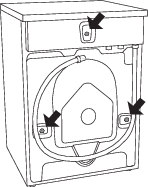
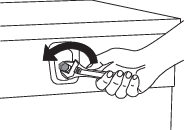
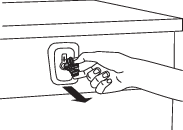

 .
.
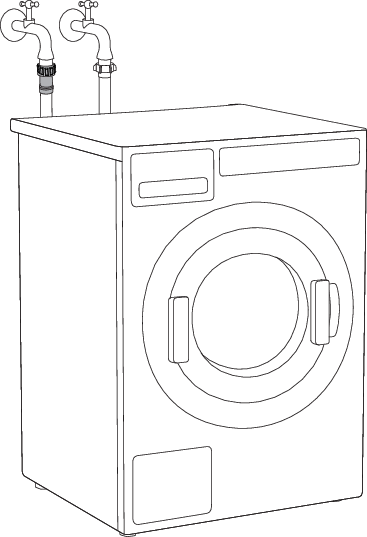


















































 /
/
